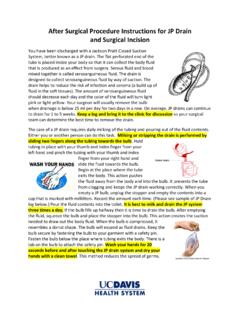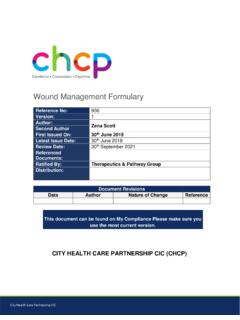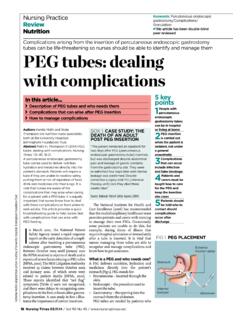Transcription of Wound Dressing Guide - Research
1 Healthy skinChampions for Skin IntegritypromotingThis project was funded by the Australian Government Department of Health and Ageing under the Encouraging Better Practice in Aged Care (EBPAC) programWound Dressing Guide The Wound Dressing Guide can be accessed online via for Skin Integrity Wound Dressing Guide Authors: Edwards H, Finlayson K, Parker C, Kaim K, Francis M. 2019 Brisbane: Queensland University of Technology. E: Gibb M, Jensen 978-1-921897-79-5healthy skinChampions for Skin IntegritypromotingWound Dressing Guide 1 Table of contents1 Introduction ..32 alginate iodine absorbent ..18 Hydrogels ..21 Hydrophobic saline dressings ..27 Low-absorbent dressings ..27 Medical-grade honey gauze films.
2 35 Silicone dressings ..37 Silver Frequently asked questions ..424 References ..48healthy skinChampions for Skin Integritypromoting2 Wound Dressing Guide 2healthy skinChampions for Skin IntegritypromotingWound Dressing Guide 31 IntroductionThe purpose of this resource is to provide a Guide on commonly available Wound Dressing products. Wound dressings are designed to help healing by optimising the local Wound environment. There is little evidence that any Dressing is superior to another. The main reasons that we apply dressings include the following: To provide rapid and cosmetically acceptable healing To remove or contain odour To reduce Wound -related pain To prevent or treat infection To contain exudate To cause minimum distress or disturbance to the patient Before applying any Dressing you should ask yourself these questions: What is the action of the Dressing ?
3 When should it be used? What are the limitations or contraindications to its use? Do I know the correct method of application and removal? Do I have sufficient knowledge about the Dressing and have I been trained to use it? Dressing selection is based on: Characteristics of the Wound , including: -Location -Extent of tissue damage (depth) - Wound size -Phase of healing -Level of exudate -Pain -Odour -Infection Factors affecting Wound healing, -Cost-effectiveness -Patient centered concerns -Many other factors When performing a Wound Dressing it is not uncommon that you may need to use a combination of dressings . The Dressing in contact with the Wound bed is known as the primary Dressing . If a Dressing is required to absorb leakage or to secure a primary Dressing , it may be referred to as the secondary Dressing .
4 The information contained in this resource is not exhaustive or prescriptive. This source is a Guide only and does not replace clinical judgement nor does it constitute endorsement of any product or organisation. For specific instructions regarding use of Dressing products always refer to manufacturer s directions. healthy skinChampions for Skin Integritypromoting4 Wound Dressing Guide healthy skinChampions for Skin IntegritypromotingWound Dressing Guide 52 AlginatesWhat are the properties of alginate dressings ? Alginates are made from seaweed When the Dressing comes into contact with Wound fluid it absorbs the fluid and turns into a gel like substance The Dressing is highly absorbent it can absorb up to 20 times its weight Some of the alginate dressings (calcium alginates) have haemostatic properties and are ideal for bleeding woundsIn what forms are they produced?
5 Ropes Sheets in varying sizesWhen should I use them? Filling irregular shaped wounds such as cavities, abscesses and sinuses (see application tips on next page) Alginate dressings are recommended in infected wounds providing the patient has appropriate antibiotic coverage, and chronic wounds for their absorbency and ability to maintain a moist Wound environment For moderately to heavily exuding wounds For bleeding wounds For Cavities/wounds with depth or underminingWhen should I avoid using them? Wounds with minimal exudate Wounds with dry, hard, necrotic tissue Third-degree burns Heavily bleeding wounds How long should I use them? If the Wound is draining heavily, alginates may need to be changed daily or when there is 70% strikethrough (visible exudate) on the secondary Dressing .
6 As drainage decreases, Dressing frequency can be reduced to every two to four days or even once the drainage stops or the Wound bed looks dry, stop using the alginate Dressing and re-evaluate the skinChampions for Skin Integritypromoting6 Wound Dressing Guide 22 Myth You can pre-moisten alginate dressings before you apply them? FalseReason: The action of the Dressing is to absorb fluid so if you moisten the Dressing then it will not be able to absorb any fluid. I can use creams such as Flamizine in conjunction with an alginate Dressing ? False Reason: Creams such as Flamizine are antimicrobials which release a large amount of silver over a very short period of time (approximately 12 hours). Alginate dressings are designed to stay on for at least 24 hours.
7 Also if you combine these two dressings the Flamizine will form a scum over the Wound surface. The alginate Dressing will also be unable to do its job of absorbing any exudate. Application tip Before using an alginate Dressing in a cavity make sure that you are able to see (visualise) the base of the Wound bed Also, if you use more than one piece, document clearly how many pieces were usedReason: The Dressing may slip down into the base of the Wound , or a piece may be missed and left there at the next Dressing change. This may then act as a foreign body resulting in delayed Wound healing and possible Wound infection Cut the alginate Dressing to the size of the Wound surface and then cover with a secondary Dressing To reduce pain during Wound Dressing changes it is recommended that you moisten the Dressing to make removal easier and less traumatic Ensure you flush all alginate fibres out of the Wound at each Dressing change as retained fibres can be reabsorbed and negatively affect Wound healingAlginates continuedhealthy skinChampions for Skin IntegritypromotingWound Dressing Guide 72 Dressing examples:DressingSupplierKaltostatConvat ecMelgisorb Monlycke ActivHeal Alginate Sutherland Medical Algisite MSmith & Nephew Cut Dressing to Wound size.
8 Alginate dressings laterally wick and this may cause the surrounding skin to macerate and breakdown. A secondary Dressing will be required foam or super absorbent a moist environment Can only be used on exuding woundsKeeps nerve endings moist and can reduce painDressings can sometimes adhere to the woundMay be used in sinuses and cavities (if able to see the base of the Wound bed) Requires a secondary Dressing Moderately to highly absorbent Sometimes mistaken for slough in the woundSuitable for bleeding wounds Can sometimes sting or cause discomfortVenous leg ulcersGranulating tissueSloughy tissueGranulating tissueAlginates continuedhealthy skinChampions for Skin Integritypromoting8 Wound Dressing Guide 2 Antibacterial alginate gelsWhat are the properties of antibacterial alginate gels?
9 Hydrated alginate gel embedded with antibacterial enzymes including glucose oxidase also found in honey and lactoperoxidase. The glucose oxidase converts glucose, oxygen and water from the Wound exudates into peroxide ions. The peroxide ions are captured by the lactoperoxidase and converted into reactive oxygen species thereby exerting a bactericidal effect. This category of dressings is referred to as enzyme what forms are they produced? Alginate gel When should I use them? Infected or highly colonised wounds Wounds with offensive odour Leg and diabetic foot ulcers Pressure injuries Abrasions Cancerous wounds ADVANTAGESDISADVANTAGESR educes odourMay need a secondary Dressing Absorbs exudateMay cause macerationReduces bacteria Some patients experience transient stinging or burning on applicationProvides moist Wound environment Dressing examples:DressingSupplierFlaminal Forte FlenPharma Flaminal Hydro FlenPharma healthy skinChampions for Skin IntegritypromotingWound Dressing Guide 92 Cadexomer iodine dressingsWhat are the properties of cadexomer iodine dressings ?
10 Made up of micro beads that contain iodine The cadexomer base absorbs exudate, swells and forms a gel Iodine is released progressively into the Wound Iodine exerts an antimicrobial effect and bacteria are removed from the Wound surface by the process of capillary actionIn what forms are they produced? Paste Powder SheetWhen should I use them? Low to heavily exudating wounds Can be used on infected woundsWhen should I avoid using them? During pregnancy or lactating women People with thyroid disease Suspected iodine sensitivitiesHow long should I use them for? Review every two weeks Treatment duration should not exceed three months Until clinical signs of infection are resolved nil odour, healthy red granulating tissue, nil slough and not hot to touchApplication tip If applying paste onto the Wound , remove the plunger from a 2ml syringe, put paste into the back of the syringe, reapply the plunger and gently squirt onto the Wound surface.






